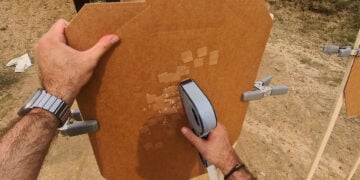Probably every handgun shooter will experience a malfunction or stoppage of some kind over his/her lifetime. Are you prepared now to handle the many types of mechanical, physical equipment, procedural, and related failures that might occur? Can you identify the various types of malfunctions and stoppages? Do you know what to do if you have a squib load, stovepipe, hang fire, or double feed? Failure to fix the failure or clear a stoppage can prevent the shooter from rapidly getting follow-up shots on target or quickly resuming the gunfight to save his/her life. So it is just a matter of time for this to occur, is critical to identify the problem and fix it, and do so quickly in the field when it happens.
In my opinion, it is imperative that every shooter has complete confidence that his/her handgun will function mechanically 100% of the time, especially for personal, concealed carry, and home defense, and that in reality it does. While the problem may be you haven’t fired at least 500 rounds through your handgun to properly “break it in,” there are several different specific failures that can occur in semi-automatic pistols and in revolvers. Yes, mechanical failures do occur with revolvers, despite what some think. For example, extracting spent cases and the ejector star for ejecting cases or a locked cylinder. Primer, gunpowder, bullet wax residue, dirt, grime, and sludge naturally buildup in the nooks and crannies of the active parts of all handguns. After even a short time of accumulation, it will hinder the ability of the gun to function correctly and efficiently. Wouldn’t it be nice to prevent these handgun failures to function?

Well there is something basic you can do that goes a long way toward preventing them. Regularly CLEAN YOUR HANDGUN. If the shooter happens to experience a failure of any kind, it is important to first ensure that the handgun is clean. A dirty gun is the cause of a high percentage of mechanical failures and stoppages. Some estimate that poor maintenance and cleaning of guns account for approximately 80% to 90% of all mechanical function problems. This is something easily in your control and you should always use thorough and proper methods when cleaning your handguns. Without a doubt, a regular, frequent, and meticulous cleaning routine is of paramount importance for handgun accuracy and reliability. Don’t get lazy about this. The military most certainly instilled that into my handgun maintenance routine. Bottom Line: Regularly Keep your Handgun Clean, Maintained, and Lubricated to Help Prevent Malfunctions and Stoppages. Of course, there are those that claim the well-made guns of today do not need frequent cleaning. That you should wait and fire at least 500 rounds for break-in BEFORE any cleaning. Some, like an instructor I recently met, even boast that they have not cleaned their gun in a year and have fired 3,000 rounds through it. A few even say “Wait till my accuracy is affected, then I’ll clean it.” Do you really want to bet your life on that infrequent cleaning, even though it will take just a few minutes to clean it and will better ensure your safety and the life of your handgun? Some may think it overkill, but my policy is to clean my gun EVERY time I use it, even if I only fired 50 rounds through it. Of course, a thorough cleaning is best, but even running a “snake” through the bore helps to reduce the possibility of lead and copper fouling build up and corrosion… and the dreaded pitted barrel. My policy is to clean my guns after every use WITHIN 24 hours. And I really use my guns frequently. While I really hate to clean guns, I “bite the bullet” so to speak and clean them to help with their reliability, accuracy, efficiency, longevity, and overall performance. Just my ideas. YOUR decision.
The malfunction or stoppage may be caused by lack of focus on the fundamentals… by YOU. So, you can control it. I frequently see in every class a new, or even experienced shooter, that “Limp Wrists” a gun and does not grip it really tight with a locked wrist. They allow the handgun to move in their hands, causing inaccuracies and jams, and this is largely preventable by the shooter. Semi-automatic pistols are powered by recoil and if you allow the gun to move in your hands, you absorb the recoil energy incorrectly, do not dissipate it through your radius and ulna bones of your arm, and cannot control the hits. So know the proper grip, be open to possibly improving it, and very FIRMLY grip the handgun, like a very firm handshake. Another important fundamental is to know how to properly use your handgun’s safety device and keep it clean. Safety devices are mechanical and may not function correctly, as with anything mechanical. It may not work properly and cause an unexpected, rapid-fire discharge. This is especially true with a poorly maintained handgun and a dirty safety.
Also, ammunition can be a source of malfunctions, stoppages, and failures. A misfire (or dud), for example, is a cartridge malfunction where there is failure of the primer and/or powder within a cartridge to function as designed and expected, when the trigger is pressed. There is the dreaded click and no “bang.” Remember someone said the two sounds you never want to hear from your handgun are (1) a click when it was supposed to go bang, and (2) a bang when you thought it would go click. Also, the round may have a case head separation when the casing walls become fatigued or are thin, causing the casing to separate when the handgun is fired. Usually this occurs with brass that has been reloaded many times. Bottom Line: Buy ammunition from quality manufacturers that have solid reputations and reliable quality control processes, even if it is more expensive, and like the NRA suggests only use manufactured rounds, not reloads, for personal, concealed carry, and home defense. Usually you do get what you pay for. Take the time to try various ammo brands and discover the best performing cartridges for your particular handgun and stay with it for consistency and performance. You might have to change ammo brands and even bullet weights. For example, in some of my 9mm pistols, I find that heavier 124 grain rounds (Vis-Ã-Vis 115 grain) perform better, impact the target higher, and are more accurate.
This article addresses malfunctions, stoppages, and jams in both pistols and revolvers. I will offer my definitions and ideas about what kinds of failures can and do occur, what the usual causes are, and how to resolve them.
Primary categories of Malfunctions include Failure to Fire, Failure to Feed (FTF), Failure to Extract, and Failure to Eject a cartridge. Some other concerns are failure to fully cycle after firing and failure of a handgun to lock back when empty. Here are some definitions and my ideas, but accept that I am NOT a gunsmith.
- FAILURE TO FIRE (Misfire). This occurs when the trigger is pressed, the sear releases the hammer, the firing pin hits the cartridge, but it does not fire. There is an indentation on the round’s primer or rim, but there is no bang. The Misfire occurs because either the round was a dud or there was a hang fire. It may be due to a faulty primer or the handgun’s firing pin, etc. The primer or gunpowder in the cartridge malfunctions and does not work causing the handgun to not discharge. The primer is a metal cup and a chemical priming compound is inside the cup. The idea is that the firing pin impacts the chemical compound causing the chemical to ignite. A “Dud” cartridge does not fire at all and the problem is usually the ammo. Excessive carbon buildup on the firing pin may be the cause, because the full forward travel of the firing pin is restricted. Recognize that a defective or worn firing pin can give the same results. If the ammo shows a shallow indentation or no mark on the primer, it might be a firing pin malfunction. Cartridges that show a normal indentation on the primer and did not fire usually indicates faulty ammunition.
- A “Hang Fire” occurs when you press the trigger and it takes several seconds for the round to fire. It does fire, but there is a delay between the time the firing pin hits the bullet’s primer and when the round goes off. The primer goes off, but the main propellant in the cartridge doesn’t burn right away and it burns slowly until it builds up enough pressure to push the bullet out of the crimp of the cartridge and out of the barrel. This may take a few seconds to accomplish. It is VERY IMPORTANT to keep the gun pointed in a safe direction for at least 30 seconds to see if the Hang Fire round goes off. Also, KEEP YOUR FINGER OFF THE TRIGGER, never turn the handgun in any unsafe direction, and ALWAYS keep it pointed down range.
CAUTION: DANGER. If you hear an almost inaudible “Pop” or soft “Poof” sound (rather than a loud bang) and/or feel or observe reduced or no recoil during firing, immediately cease-fire. This Pop and/or reduced recoil could be the result of a round being fired without enough force to send the bullet projectile out of the barrel’s muzzle, so the bullet gets stuck inside the barrel. Don’t assume it is a misfire, hang fire, or failure to feed. STOP. There may or may not be smoke coming out of the ejection port. It is called a “Squib Load.” These usually occur in reloaded ammo, but can happen with factory ammo also. If the shooter does not notice the Squib and fires another round with the barrel blocked, there is a very high probability that the barrel could become bulged and the firearm ruined, let alone explode and lead to major injury or death to the shooter and bystanders. BE CAREFUL. I strongly suggest that you do NOT apply immediate action yourself. Remove the magazine, unload, lock the slide to the rear, and place the safety switch on. Very carefully visually (do NOT look down the muzzle end of the barrel) inspect the bore to ensure a projectile is not lodged in the barrel. If a projectile is lodged in the barrel, do NOT try to remove it. Take the handgun to a gunsmith or armorer that has the appropriate tools and experience to safely fix it without damaging the gun. Buy quality cartridges.
 FAILURE TO FEED (FTF). A FTF is when a cartridge does not load into the chamber. The handgun fails to feed a cartridge into the firing chamber for some reason. Usually the ammo or magazine are the culprits, but it could be more serious. In a semi-automatic pistol this means that the cartridge is not properly transferred from the magazine to the chamber and the slide remains partially open. Maybe only by 1/8 of an inch. When this happens, the weapon is said to be “Out of Battery”. It will not function mechanically because there is Failure to Go Into Battery. This may result in the guide rod of the spring assembly sticking noticeably out of the front of the gun. There may be a jammed round on the feedramp or an over-sized cartridge. Sometimes this may be fixed by just a hard hit with the heel of your support hand to the rear of the slide. Be careful.
FAILURE TO FEED (FTF). A FTF is when a cartridge does not load into the chamber. The handgun fails to feed a cartridge into the firing chamber for some reason. Usually the ammo or magazine are the culprits, but it could be more serious. In a semi-automatic pistol this means that the cartridge is not properly transferred from the magazine to the chamber and the slide remains partially open. Maybe only by 1/8 of an inch. When this happens, the weapon is said to be “Out of Battery”. It will not function mechanically because there is Failure to Go Into Battery. This may result in the guide rod of the spring assembly sticking noticeably out of the front of the gun. There may be a jammed round on the feedramp or an over-sized cartridge. Sometimes this may be fixed by just a hard hit with the heel of your support hand to the rear of the slide. Be careful.
-
- A FTF round is usually associated with a magazine problem, e.g. the magazine spring needs cleaning or possibly it’s a bad follower. It is also possible the magazine was not inserted properly in the mag well. A very small amount of lubrication on the feed lips of the magazine may work for this. After checking to see if your magazines are in good working order, your next step would be to switch ammo. Recognize that some guns are finicky.
-
- There are several CAUSES why a firearm couldFTF a cartridge (Recognize I am NOT a gunsmith):
- Dirt: Accumulation of dirt, grime, lead, or grease in the chamber can cause the cartridge not to sit properly inside the firing chamber.
- Damaged magazine or spring: If the magazine has dents, bulges or damaged feed lips, they may cause the cartridge to be misaligned as it is being fed into the chamber. A weak or broke magazine spring may also cause FTF.
- Improperly loaded magazine: The magazine could be in good condition, but it may not be pushed all the way into the firearm, which may cause the cartridges to not enter the chamber correctly.
- Damaged cartridge: Sometimes the cartridge may have dents or bulges in it or be defective which could cause a FTF, as the slide action may not pick it up correctly, or it may not fit into the chamber tightly because of dents or bulges, etc. The bullet may be forced back into the cartridge case, which could result in a stubbed round, or separated cartridge with parts left in the chamber.
- “Riding the Slide”: This is when the shooter holds the slide and helps it move forward and impedes its speed. Many do not recognize they are doing this. Almost every class I see students who are too gentle and slow when they rack the slide or rack incorrectly. When this happens, the slide may not have enough momentum to properly seat the cartridge in the chamber. The shooter must pull the slide back as far as it will go rearward and then LET IT GO QUICKLY so the recoil spring can do the job of loading the next cartridge. This is controllable by the shooter.
- There are several CAUSES why a firearm couldFTF a cartridge (Recognize I am NOT a gunsmith):

- FAILURE TO EXTRACT. The cartridge fires, but the extractor does not pull the fired case from the chamber so it can be ejected. The cartridge case remains in the chamber. Another round cannot be fed into the chamber because of this. A cartridge must extract before it can be ejected. A live round feeding into the rear of an already- fired round is a Failure to Extract. Sometimes there is a “Double-Feed” in which two live rounds are trying to feed into the chamber at the same time. An un-fired live round is still in the chamber and a second live round has been picked up from the magazine and forced against the unfired round also in the chamber. See above picture. The gun is out of battery with the slide partially open or locked back, so you can see both the first cartridge and the second cartridge wedged together. Dirty, fouled, rusted, or corroded chambers and extractor claw and/or a damaged extractor, broken or weak extractor spring, or short recoil cycles may cause this. Damaged, poor, or ill-fitted magazines are usually a good source of the problem. Buy FACTORY MAGS. Also, bulges in the cartridge could cause excess friction on the sides which causes the cartridge to slip off the extractor claw. Buy QUALITY cartridges.
It is common for new shooters to cause a Double Feed by manually pulling or RACKING THE SLIDE TOO SLOWLY BACK (or not far enough back) and/or HELPING THE SLIDE GO FORWARD by “Riding the Slide” and “babying” its return action when there is already a round in the chamber. Concentrate on quickly snapping the release of the slide when in its rearmost position, so the slide can move forward under its own momentum and force. The magazine will probably be stuck and will not drop freely from the mag well. It usually takes a lot of force to vigorously strip the mag out. So, forcefully remove the mag, then rack the slide twice to eject both rounds, and then insert a fresh mag. You must practice doing this quickly to successfully do it when under fire, so CAREFULLY PRACTICE. “Limp Wristing” could also be the problem. Grip the gun very firmly and lock the wrist.
CAUTION: A Failure to Extract and a Double Feed are regarded as very serious malfunctions, requiring the use of proper tools to clear. They are difficult to clear sometimes. A live round could be left in the chamber and accidentally discharged. If a second live round is fed into the chambered live round, the handgun could explode and cause personal injury. This malfunction must be properly identified and if you are a new shooter or inexperienced, you should verify it with a range safety officer and take it to a gunsmith. Inexperienced shooters should NOT try to fix this themselves and not insert a rod or pencil into the bore through the muzzle end of the barrel. Identification is important, since inexperienced shooters might assume it is a Failure to Eject. The severity of a Failure to Extract determines the corrective action process.
- FAILURE TO EJECT (FTE). The fired case is pulled from the chamber by the extractor, but not fully ejected through the ejection port, causing the slide to lock partially open on the empty case. Sometimes the case is trapped by the slide and held in an upright position with the empty open part of the case pointing up like a chimney of a stove. Thus, the nickname for this failure of “Stovepipe.”FTE can be caused by a buildup of lead, carbon, or some fouling on the ejector spring or extractor. Also, there can be resistance in the cycling process from a corroded chamber that can hinder extraction, so then there would be a FTE the cartridge. “Limp Wristing” may again also be the problem.
I have taken the classic “Tap-Rack-Bang Drill” (T-R-B) for clearing malfunctions and modified it just slightly to what I call the Tap-Rotate-Rack-Assess-Bang Drill (T-R-R-A-B), to emphasize some things. While they are very similar, either drill is effective with most malfunctions and stoppages, but they are NOT effective in all cases. Some failures require more complicated maintenance or gunsmith work, but in emergency tactical situations, these drills are still a useful approach. It takes practice to engrain the steps into your muscle memory and for success. So make wise decisions in your specific SITUATION, be CAREFUL, and decide for YOURSELF what you will do and how you will do it. Here are my T-R-R-A-B Drill steps:
- T– TAP means to VERY firmly use your support-hand palm heel and strike/slam the bottom of the magazine to ensure it is seated good in the mag well so that it will feed the cartridges properly.
- R– ROTATE or invert the pistol in your shooting hand so that your thumb is slightly and naturally pointed inward (about 15-20 degrees).
- R– RACK refers to operating (cocking or cycling) the slide rearward. While racking, shake the gun slightly to the side.This will help clear any loose or mis-fired round that might be a cause of the stoppage, as well as chamber the next round.
- A– ASSESS is where you look to see if the threat still exists, to evaluate any situational changes or additional threats that may have arisen.
- B– BANG simply denotes the action of pressing the trigger to make the gun fire.
Recognize that the T-R-R-A-B Drill or the T-R-B clear some common malfunctions and stoppages, but do NOT resolve a Double Feed malfunction. If you mistakenly employ the T-R-R-A-B or T-R-B Drill for a Double Feed problem, you might make the failure worse. Use the clearance drills with caution and focus on understanding the genuine problem, your handgun, and the reason for the malfunction. Unfortunately, there is no universally-applied rule for handling all failures.
I recommend practicing the above drill for clearing malfunctions and stoppages with inert snap caps, so you are prepared if one does occur. Here are some classic, general malfunction clearance drills on YouTube from Clint Smith at Thunder Ranch. Hope they are helpful. Malfunction Clearance Clearance Drills.
Continued success!
NOTE: This personal opinion article is meant for general information & educational purposes only and the author strongly recommends that you seek counsel from an attorney for legal advice and your own personal certified weapons trainer for proper guidance about shooting & using YOUR firearms, self-defense and concealed carry. It should not be relied upon as accurate for all shooters & the author assumes no responsibility for anyone’s use of the information and shall not be liable for any improper or incorrect use of the information or any damages or injuries incurred whatsoever. BE CAREFUL!










